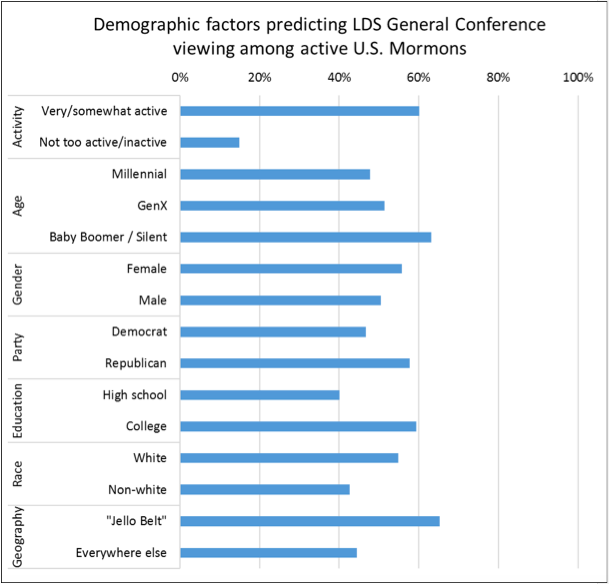A guest post by Benjamin Knoll
In a recent RadioWest episode, Doug Fabrizio interviewed Jana Riess about the “Next Mormons Survey” that she and I designed and fielded in the fall of 2016. Jana noted that the results showed that less than half of Mormon Millennials watched General Conference in the last six months.
Age undoubtedly makes a difference, but what about gender, education, race/ethnicity, or other important demographic factors? Using the “Next Mormons Survey” we are able to dig deeper into patterns of viewership of LDS General Conference.
Using a statistical tool called a “multivariate regression analysis,” we can identify the unique effect of each of these factors on General Conference viewership among our survey respondents, controlling for each of the other factors. Here we analyzed age, gender, race, education, income, political partisanship, geography, and activity level in the Church.
The analysis showed that those with higher levels of income are no more or less likely to report watching Conference than those with lower levels of income after controlling for other demographic factors. These factors, however, made a difference: [FN1]
This graph shows the likelihood of each demographic group reporting that they viewed General Conference in the last six months, statistically controlling for each other variable described above.*
Age: We continue to see a clear difference between older and younger active Mormons when it comes to General Conference viewership. Millennials and GenXers are about 48% and 51% likely to watch General Conference, respectively, compared to 63% for their older counterparts. Perhaps this is because there has never been a wider gap between the average age of Mormon General Authorities and rank-and-file members as there is right now. Younger Mormons may have a more difficult time relating to the speakers who are two to three times their age.
Some of the largest differences, though, are found in terms of church activity, geography, and education:

- Activity: As we would expect, those who say they are active or somewhat active in the Church are 45% more likely to report watching Conference than those who report being less active or inactive.
- Location: Those that live in the “Jello Belt” (AZ, CO, ID, MT, NV, NM, UT, WY) are 21% more likely to say that they watched General Conference than those who live elsewhere in the U.S. In communities with high concentrations of Mormons, there perhaps is a stronger community and peer influence to watch Conference. (Also, who wants their neighbors to catch them shopping at the grocery store during the Saturday sessions?)
- Education: Those with college degrees are 19% more likely to watch General Conference than those with a high school education. This corresponds to other research showing that education is related to higher levels of church attendance in the United States.
- Race: Race also makes a difference. U.S. Mormons who identify as white are 12% more likely than active Mormons who identify as non-white to have watched General Conference. This may be because non-white Mormons do not often find themselves reflected in the racial/ethnic identity of most General Conference speakers.
- Politics: Republicans are about 11% more likely to watch General Conference than Democrats among Mormons in the U.S. This is not surprising given the strong emphasis of political and theological conservatism that characterizes contemporary Mormon discourse, especially from General Authorities. When General Conference is full of denunciations of same-sex marriage, warnings about the loss of “religious liberty” in society, and grim statements about the overall condition of the world, it could be hard for many political liberals to feel appreciated and understood by their religious leaders.
- Gender: Gender also makes a small difference. Women are about 5% more likely to report watching General Conference than men. The fact that the vast majority of Conference speakers are men, then, does not seem to be alienating to Mormon women in terms of Conference viewership.
In sum:
- Younger Mormons are less likely to make the effort to watch General Conference than older Mormons.
- The biggest effects, though, relate to activity level, having more education, and living in Mormon communities.
- The “profile” of the typical Mormon General Conference viewer is a church-going, older, white, college-educated Republican living in Utah—not surprisingly the exact type of person most likely to be seen on the television screen during Conference sessions.
 Benjamin Knoll is is the John Marshall Harlan Associate Professor of Politics at Centre College in Kentucky and the co-author of the forthcoming book “She Preached the Word”: A Fresh Perspective on Women’s Ordination in American Congregations (Oxford).
Benjamin Knoll is is the John Marshall Harlan Associate Professor of Politics at Centre College in Kentucky and the co-author of the forthcoming book “She Preached the Word”: A Fresh Perspective on Women’s Ordination in American Congregations (Oxford).
Note: In more technical terms, every other factor in the multivariate logistic regression model achieves levels of statistical significance at p<0.05, with gender being significant at p<0.10. The model was estimated using robust standard errors to account for the presence of heteroskedasticity in the estimation.
Other findings from the Next Mormons Survey:
Mormons, Trump and McMullin: A 2016 postmortem by the numbers





